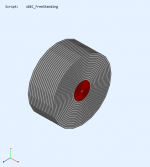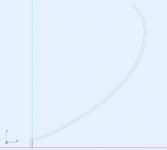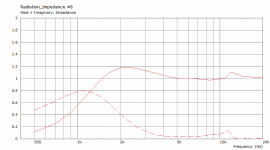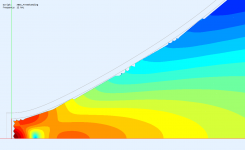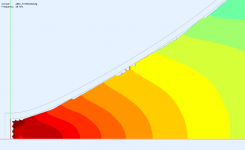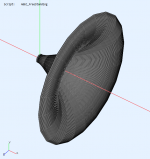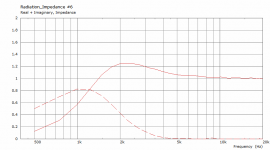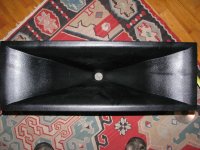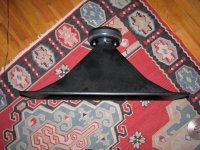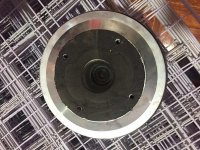...And it was the first time I enjoyed a Pilsner. Even yours that they import here, by the time they get to us aren't very good 🙂
This one?

Last time I was in Prague, I paid less than €0.15 for 0.5L in some bars 😉
Very interesting. Thank you for running them!
So some (?mild) decrease in beaming with OS, but high frequency drop-off v the beaming horn.
Patrick Bateman frequently says that at high frequencies the soundwave doesn't "see" the walls of the WG and beams. Mr. Geddes has said that the beamwidth of an OS horn at high frequencies can be wider than the throat size would suggest. I think your sims have shown this, too. Maybe 2" is simply too much.
Thank you again,
Bill
So some (?mild) decrease in beaming with OS, but high frequency drop-off v the beaming horn.
Patrick Bateman frequently says that at high frequencies the soundwave doesn't "see" the walls of the WG and beams. Mr. Geddes has said that the beamwidth of an OS horn at high frequencies can be wider than the throat size would suggest. I think your sims have shown this, too. Maybe 2" is simply too much.
Thank you again,
Bill
This one?
Last time I was in Prague, I paid less than €0.15 for 0.5L in some bars 😉
I never saw that one nor even heard of it! A Budweiser Pilsner in The Czech Republic?? Pretty gutsy (or foolish) of them. Maybe that is why it was so cheap; close to giving it away. 🙂
Reminds me of the $0.05 beer night at a dive bar in graduate school. Busch Light...
Better get back on topic before I incur the wrath of mabat.
Bill
For clarification and to conclude this OT topic:
Anheuser-Busch InBev has marketed "Budweiser" in the United States and Canada since 1876.
Budweiser Budvar Brewery (Czech: Budějovický Budvar, národní podnik) is a state-owned brewery founded in 1795 by Czech-speaking citizens of Budweis and directly continued the tradition of beer brewing in Budweis, which dates back to the 13th century.
Anheuser-Busch InBev has marketed "Budweiser" in the United States and Canada since 1876.
Budweiser Budvar Brewery (Czech: Budějovický Budvar, národní podnik) is a state-owned brewery founded in 1795 by Czech-speaking citizens of Budweis and directly continued the tradition of beer brewing in Budweis, which dates back to the 13th century.
Well this is about the kind of beaming you would have to accept if you used a 2" driver like the big Celestion, at least without employing any diffraction techniques. This is about the best I can get out of it - maybe someone else could do better. Honestly, I don't know if this is exactly what to go for. Maybe.
(⌀800 x 376 mm).
OS waveguide of a similar size - pick your poison.
At this size, I'd take the first one. Why?
The OS-throat doesn't yield significantly better directivity, whereas the first horn provides better loading > 0.8 at 450Hz versus 870Hz.
Dr. Geddes has stated several times that loading isn't as important today as it was in the past.
I tend to agree to some extent. Once you'd like to use a driver down to 600Hz, or even lower, you're gonna need a horn that 'helps the driver'.
Member Legis has shown that a naked FaitalPro HF1440 doesn't really 'do much' below 1000Hz (so, without a horn attached).
I tend to agree to some extent. Once you'd like to use a driver down to 600Hz, or even lower, you're gonna need a horn that 'helps the driver'.
Member Legis has shown that a naked FaitalPro HF1440 doesn't really 'do much' below 1000Hz (so, without a horn attached).
Patrick Bateman frequently says that at high frequencies the soundwave doesn't "see" the walls of the WG and beams. Mr. Geddes has said that the beamwidth of an OS horn at high frequencies can be wider than the throat size would suggest. I think your sims have shown this, too. Maybe 2" is simply too much.
A 2" exit driver may support wide coverage, even in the top octave, but this depends on the construction of the driver, more specifically: the phase plug and the exit (section).
With 1" exit drivers, the small waves in the top octave are more or less pulled out of the OS-throat and 'forced to stick to the horn walls'.
This is the magic of OS-waveguides.
The "pulling-out" works the same in a case of 2" driver, only not as high as for a 1" - not for as wide coverage angles. Anyway, it's a rather mild effect.
Attached is a simulation of a bare 2" driver in free field.
Attached is a simulation of a bare 2" driver in free field.
Do you know such 2" drivers?2" exit driver may support wide coverage, even in the top octave, but this depends on the construction of the driver, more specifically: the phase plug and the exit (section).
Attachments
Last edited:
Now that I have the quick sim working, I returned back to the source amplitude shading, supposed to improve on the OSWG. So far only some quick tries without much success however.
The source is divided into four concentric rings of the same widths (isn't that too coarse?).
Flat wave (amplitude = 1.0):

Shaded (amplitudes = 1.0; 0.9; 0.75; 0.5):

Seems like the beamwidth widens quite nicely overall but there's also some resonance going on.
The source is divided into four concentric rings of the same widths (isn't that too coarse?).
Flat wave (amplitude = 1.0):
Shaded (amplitudes = 1.0; 0.9; 0.75; 0.5):
Seems like the beamwidth widens quite nicely overall but there's also some resonance going on.
Attachments
Now, this is better! This is a 1.4" throat, free standing OS waveguide.
So for what driver we make such a phase plug? 🙂 Should be easier than the spherical wave.

So for what driver we make such a phase plug? 🙂 Should be easier than the spherical wave.
Attachments
Last edited:
This is it. Still a rather big one - ⌀723 x 286 mm. Probably it could be made a little smaller (or in an enclosure, even smaller).
Attachments
Last edited:
In some CDs the phase plug slots terminate at the very end of the driver, i.e. at the plane of driver-waveguide interface. I wonder if damping the individual slots by open cell foam could work, without the need to make the whole new phase plug (?).
Do you know such 2" drivers?
My own B&C DE75 is an example with an exit angle of 34.7°.
JeF111 supposedly used it with a modified C8045 Megaton horn for his PA speaker project. Judging from the severe breakup in the top octave and from his collection of measurements here, he actually used a DE85 with all-Titanium diaphragm.
Last edited:
Since ATH4 can now generate almost any horn profile, it might be interesting to clone Klipsch 'modified Tractrix' contour.
This is still a very respectable raw on-axis response (fortuitously also with DE85), considering the dimensions of the (prototype K403) horn:
W x H x D = 28 x 15 x 11 Inches.
This is still a very respectable raw on-axis response (fortuitously also with DE85), considering the dimensions of the (prototype K403) horn:
W x H x D = 28 x 15 x 11 Inches.
Attachments
Last edited:
I see what you mean, unfortunately this angle itself doesn't mean it's good or better than being flat. It still depends on how well is this conical section driven - if it's still driven by a flat phase plug output, it won't work much better. Then it depends also on the diameter of the area that drives the conical exit - the smaller the better.My own B&C DE75 is an example with an exit angle of 34.7°. ...
For this circular symmetry mode I will add an optin of importing an arbitrary user-defined profile in a form of a text file. So indeed any profile will be possible to simulate this way soon.
Last edited:
What's so respectable about that? It's still only a single curve, measured strangely. The horn can still behave quite badly - you just don't know from this picture.This is still a very respectable raw on-axis response (fortuitously also with DE85), considering the dimensions of the (prototype K403) horn:
W x H x D = 28 x 15 x 11 Inches.
Last edited:
I see what you mean, unfortunately this angle itself doesn't mean it's good or better than being flat. It still depends on how well is this conical section driven - if it's still driven by a flat phase plug output, it won't work much better. Then it depends also on the diameter of the area that drives the conical exit - the smaller the better.
It's a traditional annular slit plug, supposedly emitting a (semi-)spherical wavefront?
Attachments
Last edited:
- Home
- Loudspeakers
- Multi-Way
- Acoustic Horn Design – The Easy Way (Ath4)


